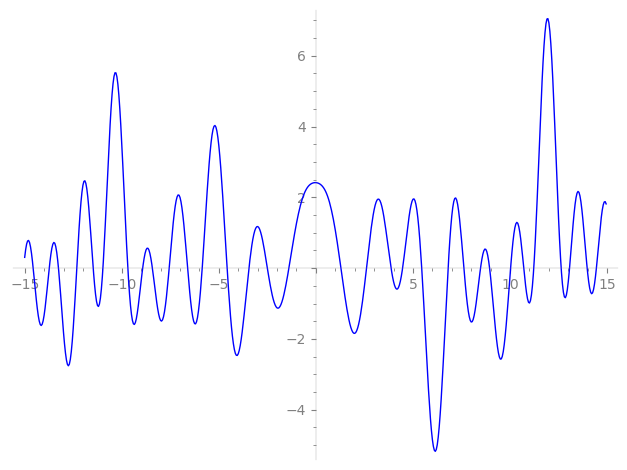| L(s) = 1 | + (1.5 − 0.866i)3-s + 0.717i·5-s + (1.62 + 2.09i)7-s + (1.5 − 2.59i)9-s − 1.73i·11-s + (3.62 + 2.09i)13-s + (0.621 + 1.07i)15-s + (−2.74 − 1.58i)17-s + (0.5 + 0.866i)19-s + (4.24 + 1.73i)21-s + 2.74i·23-s + 4.48·25-s − 5.19i·27-s + (0.621 + 1.07i)29-s + (−2 − 3.46i)31-s + ⋯ |
| L(s) = 1 | + (0.866 − 0.499i)3-s + 0.320i·5-s + (0.612 + 0.790i)7-s + (0.5 − 0.866i)9-s − 0.522i·11-s + (1.00 + 0.579i)13-s + (0.160 + 0.277i)15-s + (−0.665 − 0.384i)17-s + (0.114 + 0.198i)19-s + (0.925 + 0.377i)21-s + 0.572i·23-s + 0.897·25-s − 0.999i·27-s + (0.115 + 0.199i)29-s + (−0.359 − 0.622i)31-s + ⋯ |
Λ(s)=(=(1008s/2ΓC(s)L(s)(0.996+0.0862i)Λ(2−s)
Λ(s)=(=(1008s/2ΓC(s+1/2)L(s)(0.996+0.0862i)Λ(1−s)
| Degree: |
2 |
| Conductor: |
1008
= 24⋅32⋅7
|
| Sign: |
0.996+0.0862i
|
| Analytic conductor: |
8.04892 |
| Root analytic conductor: |
2.83706 |
| Motivic weight: |
1 |
| Rational: |
no |
| Arithmetic: |
yes |
| Character: |
χ1008(31,⋅)
|
| Primitive: |
yes
|
| Self-dual: |
no
|
| Analytic rank: |
0
|
| Selberg data: |
(2, 1008, ( :1/2), 0.996+0.0862i)
|
Particular Values
| L(1) |
≈ |
2.415805328 |
| L(21) |
≈ |
2.415805328 |
| L(23) |
|
not available |
| L(1) |
|
not available |
L(s)=p∏Fp(p−s)−1 | p | Fp(T) |
|---|
| bad | 2 | 1 |
| 3 | 1+(−1.5+0.866i)T |
| 7 | 1+(−1.62−2.09i)T |
| good | 5 | 1−0.717iT−5T2 |
| 11 | 1+1.73iT−11T2 |
| 13 | 1+(−3.62−2.09i)T+(6.5+11.2i)T2 |
| 17 | 1+(2.74+1.58i)T+(8.5+14.7i)T2 |
| 19 | 1+(−0.5−0.866i)T+(−9.5+16.4i)T2 |
| 23 | 1−2.74iT−23T2 |
| 29 | 1+(−0.621−1.07i)T+(−14.5+25.1i)T2 |
| 31 | 1+(2+3.46i)T+(−15.5+26.8i)T2 |
| 37 | 1+(−1.62−2.80i)T+(−18.5+32.0i)T2 |
| 41 | 1+(−8.74−5.04i)T+(20.5+35.5i)T2 |
| 43 | 1+(5.74−3.31i)T+(21.5−37.2i)T2 |
| 47 | 1+(−4.24+7.34i)T+(−23.5−40.7i)T2 |
| 53 | 1+(0.621−1.07i)T+(−26.5−45.8i)T2 |
| 59 | 1+(3+5.19i)T+(−29.5+51.0i)T2 |
| 61 | 1+(−6−3.46i)T+(30.5+52.8i)T2 |
| 67 | 1+(33.5−58.0i)T2 |
| 71 | 1+13.2iT−71T2 |
| 73 | 1+(7.5+4.33i)T+(36.5+63.2i)T2 |
| 79 | 1+(−1.75−1.01i)T+(39.5+68.4i)T2 |
| 83 | 1+(5.74+9.94i)T+(−41.5+71.8i)T2 |
| 89 | 1+(14.2−8.21i)T+(44.5−77.0i)T2 |
| 97 | 1+(−5.74+3.31i)T+(48.5−84.0i)T2 |
| show more | |
| show less | |
L(s)=p∏ j=1∏2(1−αj,pp−s)−1
Imaginary part of the first few zeros on the critical line
−9.686639087677233519138041981441, −8.922435036878865869291952960451, −8.423039171619323585334585156851, −7.55811230050890886774511042675, −6.60763339465528680760884743295, −5.85567880251763762219836403259, −4.57234564297452348214584034609, −3.44849115990989611222559157105, −2.50050965034555916865752689139, −1.39194112199450662851100491356,
1.28909731602658871808620712879, 2.60564634505660515025632565159, 3.87315565694976427759297664122, 4.46520523520664842589658749324, 5.45048618529686864389697415919, 6.80974553855314858820398758567, 7.62298323539855649434383871201, 8.479716613649731953062449461639, 8.946379025948332111986667573245, 10.02845029878535939604319909301

